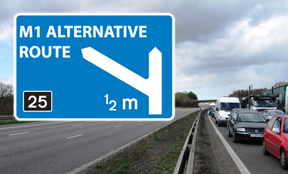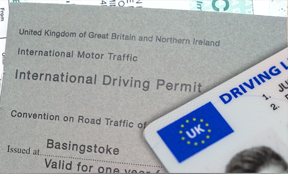
Preparing for the driving test can be a daunting experience for many learner drivers in the UK. To help you feel confident and prepared, it's a great idea to get acquainted with some of the most common driving test questions to expect when you take your practical or theory test.
In this comprehensive guide, we will cover the frequently asked questions and provide insights to help you pass your driving test. Read on to gain the knowledge and confidence needed to help bag a pass and get on the UK’s roads without the red L.
 Get your driving test preparation on the go. (Credit: gdsteam)
Get your driving test preparation on the go. (Credit: gdsteam)
Why is it Important to know the most common driving test questions?
Here, we look at the types of questions and knowledge you will need to pass your driving test for the non-practical elements in the UK test.
Understand the Test Structure: Familiarising yourself with the common questions will give you an insight into the structure of the driving test, allowing you to better prepare.
Confidence Boost: Knowing what to expect can boost your confidence and help you perform better during the actual test by lessening the risk if anxiety is taking over.
Focus on Essential Areas: Common questions often cover crucial driving knowledge and road safety rules that you must understand to pass the test.
General Driving Test Questions:
When preparing for your driving test, it's essential to have a solid understanding of general driving knowledge. Here are some of the most common questions that you may encounter:
Vehicle safety checks:
Importance of Vehicle Safety Checks: Learn about the importance of conducting regular safety checks on your vehicle to ensure it is in good working condition.
Essential Safety Checks: Understand the specific safety checks you may be asked to demonstrate during your driving test, such as checking the tyres, lights, brakes, and fluid levels. You may be asked more obscure questions, but these are great areas to swat up on to maximise your chances of passing.
Traffic signs and signals:
Understanding Traffic Signs: Gain knowledge on the various traffic signs, signals, and road markings, and their meanings to navigate the roads safely. This might sound obvious, but putting in the hours here will help to instil confidence for the test and make you a much safer driver in the long term.
Road Markings and Lane Discipline: Learn about the different types of road markings and their significance, along with proper lane discipline and positioning. Again, getting an in-depth knowledge covering subjects such as roundabouts will ensure you’re prepared to pass.
Road rules and procedures:
Right of Way: Understand the rules regarding right of way, including who should yield in different situations.
Overtaking and Lane Discipline: Learn about proper overtaking techniques and when it's appropriate to change lanes on the road – and when you are not permitted to do so by the likes of signs and road markings.
Emergency Procedures: Be prepared for questions related to emergency procedures, such as vehicle breakdowns, accidents, and how to handle them safely. Don’t forget to pay attention to motorway safety – both normal and so-called smart motorways with all-lane running.
Speed limits and stopping distances:
Understanding Speed Limits: Familiarise yourself with the different speed limits applicable in various road conditions and types.
Stopping Distances: Learn how stopping distances can vary depending on factors such as speed, road conditions, and reaction time. Such safety knowledge will help the examiner see you as a trustworthy and competent driver.
Hazard Perception Test:
The hazard perception test is an essential part of the driving test in the UK. Here's what you need to know:
Purpose and format of the Hazard Perception Test:
Understanding the Test: Learn about the purpose of the hazard perception test and how it is structured.
Identifying Hazards: Gain insights into recognising and responding to potential hazards on the road, such as pedestrians, cyclists, vehicles, and unexpected situations.
Scoring System: Understand the scoring system used for the hazard perception test and strategies to maximise your score.
And finally:
Becoming a competent and safe driver requires comprehensive knowledge of the most common driving test questions. There are no easy solutions, but putting in the hours and referring to our guide and official DVSA information will help give you the chance of swapping your provisional licence for the full photocard driving licence and the freedom it brings. Good luck.
Latest motoring news
Take a look at more of our top motoring-related content here...
-
CAR TAX SHOCK: How much is my car tax going to go up by?
-
CAN I STILL DRIVE?: My driving licence has expired - can I keep driving while I wait for a new one?
-
DRIVERS IN 20MPH PERIL: How fast in a 20mph zone will get a speeding ticket in London
-
TOP EVS FOR BRITS: What is the most popular electric car (EV) for UK buyers?
-
TESTING TIMES: Can I book cancelled driving tests to beat the rush?
-
M25 JAM BUSTER: M25 alternative routes
-
SECRET PARKING FINES: Secret parking offences you're committing but don't realise
-
SUNGLASSES SHOCK: Are my sunglasses legal for driving - how to check instantly?
-
NUMBER PLATES EXPLAINED: How old is a car by its number plate? Full list
-
SPEEDING TICKET CHECK: Will I always get a speeding ticket after being flashed
-
AVOID POINTS: Will I get a speed awareness course instead of points?
-
DRIVING ABROAD DOCUMENTS: Do I need an international driving permit for France, Spain, Greece and more
-
WHITE LINES EXPLAINED: What are the rules around double white lines and the risk of £1,000 fine?
-
BRUM: DEAL Do I pay the Birmingham Clean Air Zone at weekends?
-
GOT YOUR NUMBER: What does my driving licence number reveal about me?
-
FAKE COP SHOCK: How to spot a fake undercover police car
-
ELECTRIC LICENCE TO DRIVE: Do I need an electric car licence and driving test in the UK?
-
VAPE RULES: Can I vape in a car with kids in it?
-
LICENCE TIMES: When can I apply for a provisional licence?
-
E-SCOOTER LAWS: Are electric scooters Legal in the UK now? When is the law changing?
-
SLIDERS MUST-KNOW: Can I drive in sliders in the UK?
-
DOT CHECK: What are the black dots on my windscreen for?
-
CAR TRACKER: How can I find out who owns a car
-
CHARGE AND DRIVE: Electric car charging points at UK airports for public use
-
TYRE-CHECK TOOL: How old are my tyres - find out instantly here
-
CAR FUTURE: What happens to a car when the owner dies?
-
SPARE WHEEL RULES: How far and how fast can I drive on a space saver spare wheel
-
TICKET RISK: Can I be fined if the car park ticket machine is not working?
-
M6 JAM BUSTER: Is the M6 Toll Road free in the evening and at weekends?
-
PAY OR NOT PAY: How much is the Tamar Bridge toll and when do I need to pay it?
Subscribe for free motoring and travel news from PeteBarden.co.uk
Author: Pete Barden:
Twitter: @pete_barden
Pete Barden is a qualified journalist who has written and produced for publications including The Sun (thesun.co.uk), New Statesman Media Group, Whatcar? (Whatcar.com) Stuff Magazine (Stuff.tv), Fastcar Magazine (Fastcar.co.uk), Maxim Magazine and UK broadcast stations within the Heart network (Formerly GCAP). Pete specialises in motoring and travel content, along with news and production roles. You can find out more about Pete Barden on LinkedIn.











